Emory University
Las últimas cargas en Emory University. ¿Buscando notas en Emory University? Tenemos muchas notas, guias de estudio y notas de estudio disponsible para tu escuela.
-
254
- 0
-
10
All courses for Emory University
-
AGNP Board Exam AGNP 1
-
AGNP Board Exam on Cardiovascular assessment AGNP 1
-
ANT 200: Foundations of Behavior ANT 200 1
-
ATI Pharmacology ATI 1
-
BIO_250_QUIZ_ 1
-
BIO_250_QUIZ_2 straighterline 2020 1
-
BIO_250_QUIZ_3 straighterline 2020 1
-
ESSENTIALS OF HUMAN ANATOMY AND PHYSIOLO 1
-
Intro to Film FILM101 6
-
MESAS 370W - The Crusades Through Middle Eastern Eyes MESAS370W 3
-
NRSG 202 NRSG 202 1
-
NRSG 328 3
-
NRSG 329 1
-
NRSG 430 4
-
NRSG 465 NRSG465 8
-
NRSG 485 NRSG485 2
-
NURS 329 NURS 329 2
-
NURS 6512 6512 1
-
NURS329 NURS329 2
-
Psychology 200W - Experimental Methods In Lab 1
-
RNs and PNs Nursing NCLEX 1
Libros populares Emory University

David Bordwell, Kristin Thompson, Jeff Smith • ISBN 9781260056082
David Bordwell, Kristin Thompson • ISBN 9780078007873
Últimos notas y resúmenes Emory University
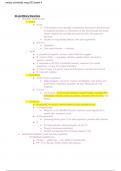
GI and Biliary Disorders ● Hepatitis: inflamed liver ○ Patho ■ Acute ● Viral infection, liver damage, cholestasis: decrease in bile flow due to impaired secretion or obstruction of bile flow through bile ducts (retain substances normally excreted into bile: bile salts and bilirubin) ● Usually no long-lasting effects; liver cells regenerate ■ Chronic ● Hepatitis c ● Can cause fibrosis → cirrhosis ○ Types ■ A: prevent by hygiene, vaccine, wash fruits and veggies ...
- Package deal
- Examen
- • 24 páginas's •
-
Emory University•NRSG 533
-
NRSG 533 - Emory University Tests Compilation Bundle• PorClassroom
Vista previa 3 fuera de 24 páginas
GI and Biliary Disorders ● Hepatitis: inflamed liver ○ Patho ■ Acute ● Viral infection, liver damage, cholestasis: decrease in bile flow due to impaired secretion or obstruction of bile flow through bile ducts (retain substances normally excreted into bile: bile salts and bilirubin) ● Usually no long-lasting effects; liver cells regenerate ■ Chronic ● Hepatitis c ● Can cause fibrosis → cirrhosis ○ Types ■ A: prevent by hygiene, vaccine, wash fruits and veggies ...
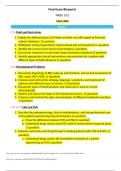
C16 Fluid and Electrolytes 1. Explain the different types of IV fluids and their use with regard to fluid and sodium imbalance. (2 question) 2. Distinguish among hypovolemia, hypervolemia and normovolemia (1 question) 3. Identify the normal serum levels of electrolytes (1 question) 4. Discuss the treatment of each hyper/hypo electrolyte imbalance (1 question) 5. Identify appropriate clinical interventions and evaluation for a patient with different types of fluid imbalance (1 question) C...
- Package deal
- Examen
- • 5 páginas's •
-
Emory University•NRSG 533
-
NRSG 533 - Emory University Tests Compilation Bundle• PorClassroom
Vista previa 2 fuera de 5 páginas
C16 Fluid and Electrolytes 1. Explain the different types of IV fluids and their use with regard to fluid and sodium imbalance. (2 question) 2. Distinguish among hypovolemia, hypervolemia and normovolemia (1 question) 3. Identify the normal serum levels of electrolytes (1 question) 4. Discuss the treatment of each hyper/hypo electrolyte imbalance (1 question) 5. Identify appropriate clinical interventions and evaluation for a patient with different types of fluid imbalance (1 question) C...
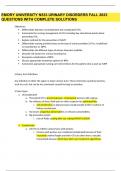
Objectives: Differentiate between uncomplicated and complicated UTIs. Summarize the nursing management of UTIs including key educational points about preventing UTIs. Explain methods for the prevention of CAUTI Differentiate nursing priorities base on the type of urinary problem (UTI vs. Urolithiasis vs Incontinence vs. BPH). Differentiate the different types of urinary diversion available. Describe risk factors for urinary incontinence. Recognize complicatio...
- Package deal
- Examen
- • 15 páginas's •
-
Emory University•NRSG 533
-
NRSG 533 - Emory University Tests Compilation Bundle• PorClassroom
Vista previa 2 fuera de 15 páginas
Objectives: Differentiate between uncomplicated and complicated UTIs. Summarize the nursing management of UTIs including key educational points about preventing UTIs. Explain methods for the prevention of CAUTI Differentiate nursing priorities base on the type of urinary problem (UTI vs. Urolithiasis vs Incontinence vs. BPH). Differentiate the different types of urinary diversion available. Describe risk factors for urinary incontinence. Recognize complicatio...

Emory University NRSG 533 Urine Disorder Handout ANSWERS FALL 2023
- Package deal
- Examen
- • 15 páginas's •
-
Emory University•NRSG 533
-
NRSG 533 - Emory University Tests Compilation Bundle• PorClassroom
Vista previa 2 fuera de 15 páginas
Emory University NRSG 533 Urine Disorder Handout ANSWERS FALL 2023
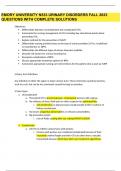
Objectives: Differentiate between uncomplicated and complicated UTIs. Summarize the nursing management of UTIs including key educational points about preventing UTIs. Explain methods for the prevention of CAUTI Differentiate nursing priorities base on the type of urinary problem (UTI vs. Urolithiasis vs Incontinence vs. BPH). Differentiate the different types of urinary diversion available. Describe risk factors for urinary incontinence. Recognize complicatio...
- Package deal
- Examen
- • 15 páginas's •
-
Emory University•NRSG 533
-
NRSG 533 - Emory University Tests Compilation Bundle• PorClassroom
Vista previa 2 fuera de 15 páginas
Objectives: Differentiate between uncomplicated and complicated UTIs. Summarize the nursing management of UTIs including key educational points about preventing UTIs. Explain methods for the prevention of CAUTI Differentiate nursing priorities base on the type of urinary problem (UTI vs. Urolithiasis vs Incontinence vs. BPH). Differentiate the different types of urinary diversion available. Describe risk factors for urinary incontinence. Recognize complicatio...
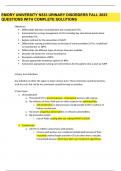
Emory University NRSG 533 Urine Disorder Handout ANSWERS FALL 2023
- Package deal
- Examen
- • 15 páginas's •
-
Emory University•NRSG 533
-
NRSG 533 - Emory University Tests Compilation Bundle• PorClassroom
Vista previa 2 fuera de 15 páginas
Emory University NRSG 533 Urine Disorder Handout ANSWERS FALL 2023
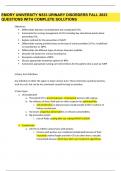
Emory University NRSG 533 Urine Disorder Handout ANSWERS FALL 2023
- Package deal
- Examen
- • 15 páginas's •
-
Emory University•NRSG 533
-
NRSG 533 - Emory University Tests Compilation Bundle• PorClassroom
Vista previa 2 fuera de 15 páginas
Emory University NRSG 533 Urine Disorder Handout ANSWERS FALL 2023
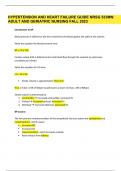
Introduction to BP. Blood pressure is defined as the force exerted by the blood against the walls of the arteries. Write the equation for blood pressure here: BP = CO x SVR Cardiac output (CO) is defined as the total blood flow through the systemic or pulmonary circulation per minute. Write the equation for CO here: CO = SV x HR Stroke volume is approximately 70mL/min True or False: A HR of 50bpm would lead to a lower CO than a HR of 80bpm Stroke volume is determined by: 1. Contra...
- Package deal
- Examen
- • 11 páginas's •
-
Emory University•NRSG 533
-
NRSG 533 - Emory University Tests Compilation Bundle• PorClassroom
Vista previa 2 fuera de 11 páginas
Introduction to BP. Blood pressure is defined as the force exerted by the blood against the walls of the arteries. Write the equation for blood pressure here: BP = CO x SVR Cardiac output (CO) is defined as the total blood flow through the systemic or pulmonary circulation per minute. Write the equation for CO here: CO = SV x HR Stroke volume is approximately 70mL/min True or False: A HR of 50bpm would lead to a lower CO than a HR of 80bpm Stroke volume is determined by: 1. Contra...
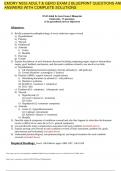
N533 Adult & Gero Exam 2 Blueprint Endocrine- 17 questions (# in parenthesis next to objective) Objectives 1) Briefly summarize pathophysiology of every endocrine organ covered a) Hypothalamus b) Pituitary c) Thyroid d) Parathyroid e) Adrenals i) Cortex ii) Medulla f) Pancreas g) Gonads 2) Explain the pathway of each hormone discussed including originating organ, target or intermediary targets, goal, feedback mechanism, and discussed conditions related to too much or too little. ...
- Package deal
- Examen
- • 3 páginas's •
-
Emory University•N533
-
NRSG 533 - Emory University Tests Compilation Bundle• PorClassroom
Vista previa 1 fuera de 3 páginas
N533 Adult & Gero Exam 2 Blueprint Endocrine- 17 questions (# in parenthesis next to objective) Objectives 1) Briefly summarize pathophysiology of every endocrine organ covered a) Hypothalamus b) Pituitary c) Thyroid d) Parathyroid e) Adrenals i) Cortex ii) Medulla f) Pancreas g) Gonads 2) Explain the pathway of each hormone discussed including originating organ, target or intermediary targets, goal, feedback mechanism, and discussed conditions related to too much or too little. ...

Endocrine Module Learning Objectives 5 Functions of the Endocrine System - Role in reproductive & CNS function - Stimulate growth & development - Sexual reproduction - Maintaining homeostasis - Responding to emergency demands 1. Briefly summarize pathophysiology of every endocrine condition covered (except parathyroid) (1) ○ Disorders of Anterior Pituitary ■ Acromegaly: caused by a benign pituitary adenoma that secretes GH (growth hormone) ● Affects: 4/million adults in US diag...
- Package deal
- Examen
- • 36 páginas's •
-
Emory University•NRSG 533
-
NRSG 533 - Emory University Tests Compilation Bundle• PorClassroom
Vista previa 4 fuera de 36 páginas
Endocrine Module Learning Objectives 5 Functions of the Endocrine System - Role in reproductive & CNS function - Stimulate growth & development - Sexual reproduction - Maintaining homeostasis - Responding to emergency demands 1. Briefly summarize pathophysiology of every endocrine condition covered (except parathyroid) (1) ○ Disorders of Anterior Pituitary ■ Acromegaly: caused by a benign pituitary adenoma that secretes GH (growth hormone) ● Affects: 4/million adults in US diag...
